Chapter: Psychology: Memory
Psychology: Memory Intrusions
Memory
Intrusions
We still need to ask why new learning seems sometimes to
disrupt old. Why can’t the newly acquired information peacefully coexist with
older memories? In fact, there are several reasons. In some cases, the new
information simply sits side by side with old memories, creating a danger that
you’ll get mixed up about which is which—recalling the newer information when
you’re trying to come up with the older. In other cases, the new information
may literally replace the old memory,
much as you delete an old version of a paper from your computer’s hard drive
once you’ve created a newer, updated version.
In most experiments, it’s difficult to distinguish these two possibilities—that is, to tell whether the new information is merely competing with the old information, or whether it has literally replaced the old information. In either case, though, the new material will lead to intrusion errors—mistakes about the past in which other infor-mation is mixed into (intrudes into) your recall. These intrusions are often small (so that you recall having a cheese sandwich when you really had a salad) but can some-times be quite large: People may confidently, vividly recall a past event that never took place at all.
THE MISINFORMATIONEFFECT
Intrusion errors can arise in
many ways. Often, though, the intrusion involves informa-tion about an event
that you learned only after the event was
over. For example, imagine that you witness a crime and see the thief flee
in a blue car. The next day, you read a newspaper account of the same crime and
learn that another witness has reported that the thief fled in a green car (Figure 8.14). How will this
experience influence your mem-ory? A number of experiments have examined this
issue by exposing participants to an event and then giving them some
misinformation about the event. In some studies, the misinformation comes from
another person’s report (“Here’s the way another witness described the event .
. .”). In other studies, the misinformation is contained within a leading
question: Participants might be asked, for example, “Did you see the children
getting on the school bus?” after seeing a video that showed no bus. In all
cases, though, the effect is the same: This misinformation is often
incorporated into the par-ticipants’ memory, so that they end up misremembering
the original event, mistakenly including the bits suggested after the fact by
the experimenter.
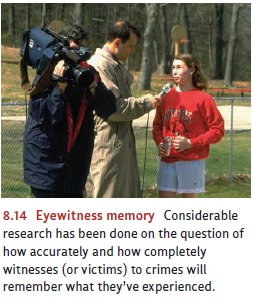
The errors produced by the misinformation effect can actually be
quite large. Participants have in fact been led to remember buses that weren’t
actually present in an event as well as whole buildings that didn’t exist
(Loftus, 2003). Indeed, with slight variations of this technique, participants
have been led to recall entire events that never occurred. In one study,
participants were asked to recall a time they had been at an outdoor wedding
and had accidentally knocked over the punchbowl, spilling it onto the bride’s
parents. With suggestive questioning, the researcher led 25% of the
participants to “remember” this nonexistent episode (I. Hyman, Husband, &
Billings, 1995). In similar experiments, participants have been led to recall a
nonexistent episode in which they were hospitalized, or a hot-air balloon ride
that really never happened (Figure 8.15), or a (fictitious) event in which they
were the victim of a vicious animal attack (Loftus, 2003, 2004; also Chrobak
& Zaragoza, 2008; Geraerts et al., 2006; Geraerts et al., 2009; Geraerts et
al., 2007; Laney et al., 2008; and many more).
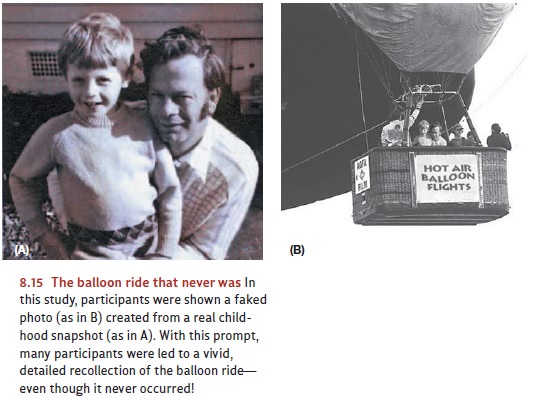
Errors like these are easily documented in the laboratory, but can also be observed in real-life settings. We are, after all, often exposed to alternate versions of events we’ve experienced—for example, whenever we discuss a shared experience with a friend, and the friend recalls things differently from the way we do. Moreover, the leading questions examined in much of this research are modeled directly on the questions sometimes asked in law enforcement investigations involving adults (“Did you see the gun?”) as well as children (“When did Uncle Seth touch you?”; cf. Bruck & Ceci, 1999; Ceci & Bruck, 1995; Melnyk, Crossman, & Scullin, 2007; Westcott, Davies, & Bull, 2002). As a consequence, we can readily find examples in which the memory errors made in the lab-oratory are mirrored by errors outside of the lab—including settings (like law enforce-ment) in which the memory mistakes are deeply troubling and potentially very costly.
INTRUSIONS FROM SCHEMATIC KNOWLEDGE
Intrusion errors, interfering
with our memory of the past, can also come from another source—because
sometimes we blur together our recollection of an episode with our broader
knowledge about the world. Classic data on this topic come from studies
per-formed by the British psychologist Frederic Bartlett more than 75 years
ago. Bartlett presented British research participants with stories drawn from
Native American folk-lore; and for these participants, many elements of these
stories seemed strange. In the participants’ recollection of these stories,
though, the tales became less strange. Parts of the tales that had made no
sense to them (such as the supernatural elements) either were left out of their
recall or were reinterpreted along more familiar lines. Similarly, participants
often added elements so that plot events that had initially seemed
inexpli-cable now made sense to them (Bartlett, 1932).
What happened here? Bartlett’s
participants quite naturally tried to understand these stories by relating them
to other things they knew and understood. In the process, they ended up
creating connections in their memories, weaving together the story elements
with various aspects of their own knowledge about the world. This weaving
together helped the participants comprehend the materials they were hearing by
linking the unfa-miliar materials to a more familiar framework. But, at the
same time, this weaving caused problems later on, because it made it difficult
for participants to keep track of which ele-ments were actually in the stories
and which were merely associated with the story via their understanding of it.
This is what produced the memory errors.
Other studies have replicated
Bartlett’s findings, showing in many contexts that memory is strongly affected
by an individual’s conceptual framework. For example, par-ticipants in one
study were told about a person’s visit to the dentist and then later asked to
recall what they had heard. Many participants remembered being told about the
patient checking in with the receptionist and looking at a magazine in the
waiting room, even though these details were not mentioned in the original
account (G. Bower, Black, Turner, 1979). In a different experiment (which we
first met in the Prologue), partici-pants waited briefly in a professor’s
office and, seconds later, were asked to recall the con-tents of the office.
One-third of the individuals “remembered” seeing books in the office, even
though none were present (Brewer & Treyens, 1981). In this case the error
is a sub-stantial one (bookshelves are large; the participants were actually in
the office; the recol-lection took place just moments after leaving the
office); but, again, it is entirely in line with participants’ expectations of
what “should” be in a professor’s office.
In all these examples, memory is
strongly affected by the research participants’ broad knowledge of the world
and by the conceptual framework they bring to the situ-ation. Following
Bartlett, many psychologists describe these frameworks as schemas— mental representations that summarize what we know about a
certain type of event or situation. Schemas reflect the simple fact that many
aspects of our experience are redundant—professors’ offices do tend to contain
many books, patients visiting the dentist do generally check in with a
receptionist—and schemas provide a convenient summary of this redundancy.
Let’s also be clear that a
reliance on schematic knowledge is generally a good thing. When we encounter an
event—whether it’s a trip to the dentist or a story from another culture—we
seek to understand it by relating it to a schematic frame. This helps us find meaning in our experience, and
it also fills in the “gaps” that result from our failing to notice this or that
detail. Then, when we try to remember the event, we rely on the same schema.
And here, too, this strategy can help us by allowing us to make reasonable
assumptions about what probably occurred, thus filling any gaps in what we
recall. Even so, this reliance on schematic knowledge can lead to substantial
memory errors. In particular, it can lead us to remember the past as being more
regular and more orderly than it actually was.
INTRUSIONS FROM SEMANTI CASSOCIATIONS
Intrusion errors can be
documented in many settings, including settings that seem designed to encourage
memory accuracy. For example, intrusion errors can be observed even with simple
stimuli, short retention intervals, and instructions that warn partici-pants
about the kinds of memory errors they’re likely to make. Even in these
settings, participants make a surprising number of memory mistakes.
Evidence for these points comes
from many studies that draw on the so-called DRMparadigm—named in honor of Deese, Roediger, and McDermott, the
researchers whodeveloped it (Deese, 1957; Roediger & McDermott, 1995, 2000;
also Blair, Lenton, & Hastie, 2002; Brainerd, Yang, Reyna, Howe, &
Mills, 2008; Sugrue & Hayne, 2006; etc.). In this procedure, participants
hear a list of words, such as bed, rest,
awake, tired, dream,wake, snooze, blanket, doze, slumber, snore, nap, peace,
yawn, drowsy. Then, immediately afterhearing the list, participants are
asked to recall as many of the words as they can.
All of the words in this list are
semantically associated with the word sleep,
and the presence of this theme helps memory and makes the words on the list
easy to recall. But as it turns out, sleep—the
root of the list—isn’t included in the presentation. Still, participants
spontaneously make the connection between the list words and this associated
word—and this almost invariably leads to a memory error. When the time comes
for recall, participants are extremely likely to remember that they heard sleep. In fact, they’re just as likely
to recall this word as they are to recall the actual words on the list (Figure
8.16)!
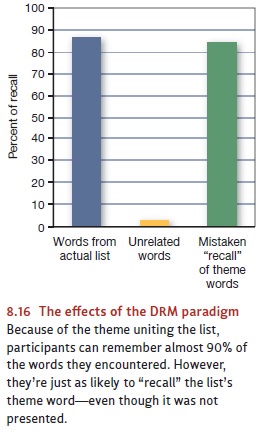
Notice once again that
participants’ background knowledge both helps and hurts them. In the DRM task,
the participants’ knowledge helps them link together the list words according
to a theme, and this strongly aids recall of the words. But the same knowledge
leads to a remarkably high level of false recall—by powerfully encouraging
recall for words that were never presented.
MISPLACED FAMILIARITY
One more mechanism plays a key
role in producing intrusion errors in memory, and, with that, in encouraging
misremembering of the past. To understand this mechanism, let’s start with the
fact that the memory processes that make a stimulus seem familiar are different from those that help us figure out why the stimulus feels familiar. As a
result, sometimes the first process succeeds, so we correctly realize that a
stimulus is familiar, but the second process fails, so we make a mistake about
the source of that familiarity.
Familiarity (a general sense that a stimulus has been encountered before) and recollection (recall of the context in which a stimulus was encountered) can bedistinguished in many ways. For a start, there’s an obvious subjective difference—in other words, these two types of memory feel different from each other—and people can reliably tell whether they “remember” a prior event (and so have some recollection) or whether they don’t remember the event, but just “know” that it happened (and so, apparently, are relying on familiarity—Rajaram, 1993; Tulving, 1985; also Aggleton & Brown, 2006). These two types of memory are also promoted by different types of strategies—so that some approaches to a stimulus or event are especially helpful for establishing a sense of familiarity; different strategies are needed for establishing the sort of memory that will later on lead to recollection.
Familiarity and recollection can
also be distinguished biologically. During learning, activity in the rhinal
cortex seems crucial for establishing a sense of familiarity; and so higher
levels of activity in this brain area, during the initial encounter with a
stimulus, are associated with greater likelihood of familiarity later on. In
contrast, areas in and around the hippocampus seem essential for establishing a
basis for recollection; higher levels of activity in these regions, during
learning, are associated with greater likelihood of subsequent recollection
(e.g., Davachi, Mitchell, & Wagner, 2003; Davachi & Dobbins, 2008;
Ranganath et al., 2003; Figure 8.17).
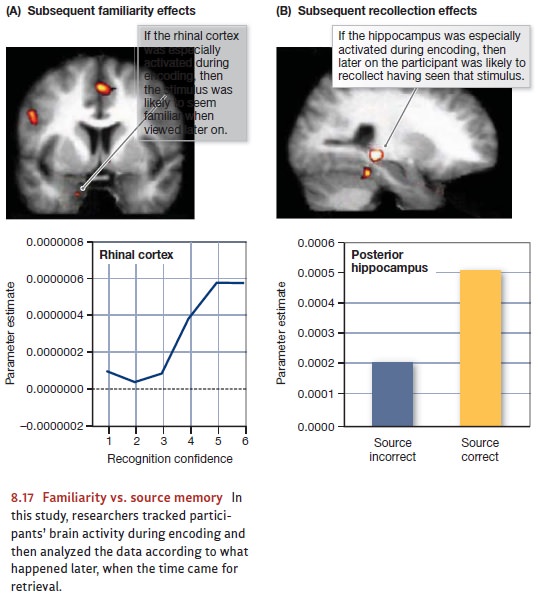
Then, during retrieval,
familiarity and recollection both rely on the prefrontal cortex; but they
depend on clearly different areas within this cortex (e.g., Diana, Yonelinas,
& Ranganath, 2007; Dobbins, Foley, Schacter, & Wagner, 2002; Kahn,
Davachi, & Wagner, 2004; Rugg & Curran, 2007; A. Wagner et al., 2005).
Therefore, the brain state of some-one who remembers seeing a stimulus earlier
is distinct from the brain state of someone who doesn’t remember the earlier
encounter but still feels that the stimulus is familiar.
This distinction between familiarity and recollection has many consequences, including the possibility of one process succeeding while the other fails. In fact, this pat-tern is easily detectable in everyday experience—when, for example, people have the frustrating experience of seeing someone, immediately knowing that the person is familiar, but not being able to figure out why the person is familiar. In that situation, you ask yourself: “Where do I know that guy from? Does he maybe work at the grocery store? At the shoe store? Where?” Here the familiarity process has succeeded—and so you’re sure the person is indeed familiar—but the recollection process, allowing you to attribute the familiarity to a specific source, has let you down.
A different problem can also
arise, and brings us back to our main agenda—the ways in which new learning can
intrude on (and thus disrupt) older learning. Here’s the situation: You notice
that a stimulus (perhaps a face, or a place) seems familiar, and you think you
know why—but you’re simply mistaken, and you attribute the familiarity to the
wrong source. This phenomenon can arise in a variety of circumstances outside
the lab, and researchers have re-created one of those circumstances in their
studies: In the experi-mental procedure, participants witness a staged crime.
Two days later, they’re shown “mug shots” of individuals who supposedly had
participated in the crime. But, as it turns out, the people in these photos are
different from the people who were actually involved in the crime; no mug shots
are shown for the truly “guilty” individuals. Finally, after a few more days,
the participants are shown a lineup like the one in Figure 8.18 and asked to
select from this lineup the indi-viduals seen in step one—namely, the original
staged crime.
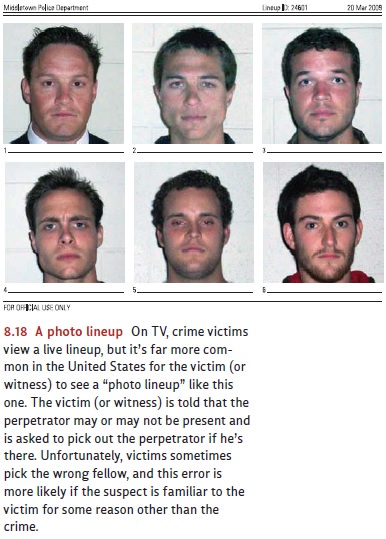
In this procedure, participants
correctly realize that one of the people in the lineup looks familiar, but
they’re often confused about the source of the familiarity. They falsely
believe they had seen his face in the original “crime,” when in truth they’d
seen it only in a subsequent photograph. In fact, the likelihood of this error
is quite high in some experiments, and sometimes more than a quarter of the
participants (falsely) select from the lineup an individual they’d seen only in
the mug shots (E. Brown, Deffenbacher, & Sturgill, 1977; also D. Davis,
Loftus, Vanous, & Cucciare, 2008).
TRYING TO AVOID MEMORY ERRORS
We’ve now discussed many
experiments in which participants made substantial memory errors. Similar
errors, as we’ve frequently mentioned, can also be documented outside the
lab—including errors in highly consequential settings. In fact, evidence
suggests that eyewitness errors in the American court system may account for
more false convictions than all other causes combined (Connors, Lundregan,
Miller, & McEwan, 1996).
These points invite two
questions: First, is there anything we can do to avoid the errors—and thus to
improve memory accuracy? Second, what do these errors imply for our overall
assessment of memory? Should we perhaps put less trust in our memories than we
generally do? Let’s tackle these questions in turn.
Some steps do seem helpful in
avoiding (or at least diminishing) memory error. For example, we noted earlier that some memory problems involve retrieval
failures, and so we can improve memory by means of instructions or strategies
that pro-mote retrieval—such as trying, at the time of recall, to reinstate the
psychological con-text of learning (for a real-world use of this procedure, see
Fisher & Schreiber, 2007). Likewise, since attention to meaning seems an
effective way to memorize, we can improve memory by encouraging people to think
more deeply about the materials they’re encountering; this will promote both
understanding and memory.
People have also suggested more exotic means of improving memory—but these seem less helpful. For example, some people have proposed the use of hypnosis as an aid to memory, based on the idea that someone—for example, an eyewitness to a crime— can be hypnotized, given the suggestion that she’s back at a certain time and place, and asked to tell what she sees. On the surface, the results of this procedure—in a police station or in laboratory studies—are quite impressive. A hypnotized witness mentally returns to the scene of the crime and seems able to recall exactly what the various participants said; a hypnotized college student mentally returns to childhood and appears to relive his sixth birthday party with childlike glee.
Careful studies reveal, however,
that hypnosis does-n’t improve memory. Descriptions of crimes or child-hood
reports elicited under hypnosis often turn out to be false when checked against
available records .
Likewise, certain drugs are
sometimes proposed as improving memory—but here too the actual benefits are
small. Some of the drugs used to promote memory (e.g., sodium amytal) are
sedatives, so they put an individual in a less guarded, less cautious state of
mind. This state does allow the person to report more about the past—but not
because she remembers more. Instead, in the relaxed state, the person is just
more will-ing to talk and less likely to discriminate between genuine memories
and fantasy. As a result, the person who has taken the drug will spin out a mix
of recollection and fiction that robs their “recall” of any value. What’s more,
this less guarded state leaves an indi-vidual more vulnerable to the effects of
leading or misleading questions, which can fur-ther undermine memory accuracy.
This evidence is more encouraging
for a different drug—ginkgo biloba—sometimes advertised as improving memory
(and other aspects of intellectual functioning). Ginkgo has an entirely
different effect from the sedatives just mentioned, and it does improve memory for
certain groups of people. Specifically, ginkgo can help with some types of
blood-circulation problems and can also reduce certain forms of inflammation.
It can therefore help people whose mental functioning has been compromised by
specific phys-ical maladies; this includes patients suffering from Huntington’s
disease or Alzheimer’s disease. There’s little evidence, however, that ginkgo
improves the memory of healthy individuals; that is, there’s no reliable effect
for people with no circulatory problems or inflammation (Gold, Cahill, &
Wenk, 2002; McDaniel, Maier, & Einstein, 2002).
Finally, there’s one more—less
exotic—step that people have tried to improve their memories: They have tried
simply being careful in their
recollection. This effort begins with the fact that we feel sure about some of
our memories (“I’m certain that he’s the guy who robbed me!”) but more
tentative about others (“I think she said it was size 6, but I’m not sure”).
The obvious strategy, therefore, is to rely only on the memories we feel sure
about and to be more cautious otherwise.
Surprisingly, though, this
commonsense strategy offers little benefit. Many studies have compared the
accuracy of memories people are certain about with the accuracy of memories
they’re not sure of. These studies often find a relationship in which confident
memories are slightly more likely to be correct than unconfident ones. But the
relation-ship is weak, and some studies have found no relationship at all
(e.g., Bernstein & E. Loftus, 2009; Douglas & Steblay, 2006; Reisberg,
2010; Semmler & Brewer, 2006; Wells, Olson, & Charman, 2002). As a
result, if we rely on our confidence in deciding which memories to trust, we’ll
regularly accept false memories and reject true ones.
Related Topics